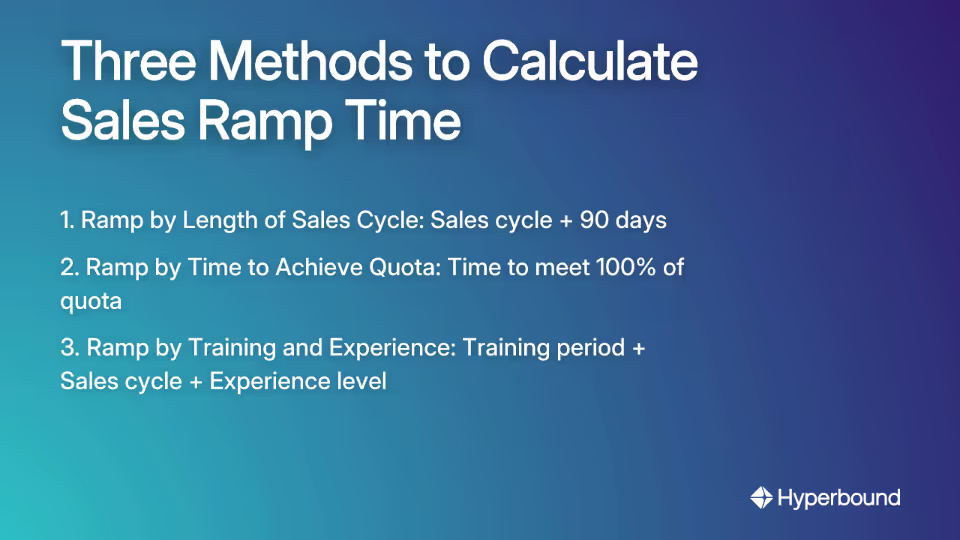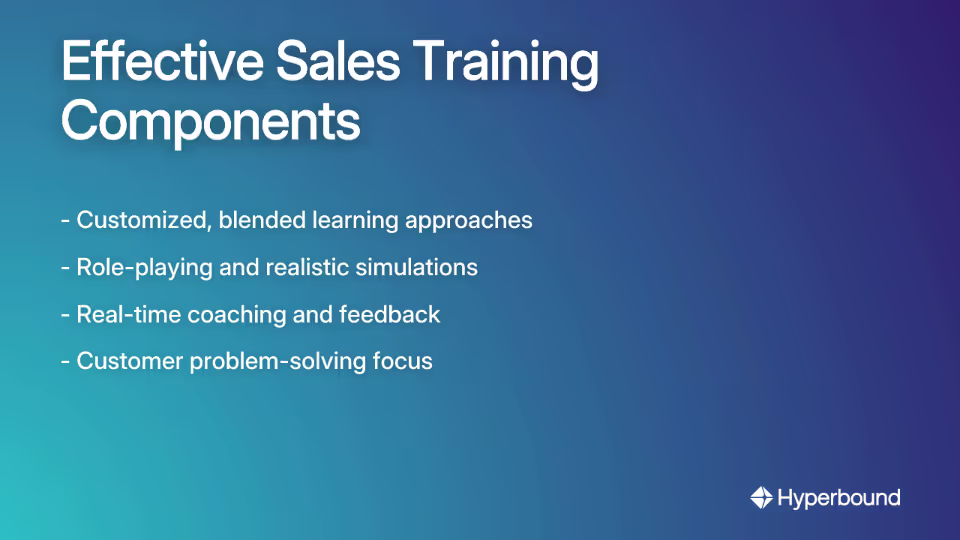
"The beginning is the most important part of any work." – Plato
You've just taken on a new sales leadership role, or perhaps you're tasked with improving your team's onboarding process. Either way, you're facing a critical challenge: how do you effectively ramp up new sales talent while setting realistic expectations that lead to long-term success?
The stakes couldn't be higher. According to industry data, ineffective onboarding is one of the primary reasons for high turnover in sales organizations. New hires often feel they're being set up for failure due to inadequate training, poor support systems, and unrealistic performance timelines that don't align with actual sales cycles.
As one sales professional noted on Reddit, "Most places have NO REAL ON-BOARDING. If onboarding takes 4 weeks and the company's usual sales cycle is 4-6 months, the new hire is disadvantaged from the start." This sentiment echoes across forums where sales professionals share their frustrations about being forced to self-navigate complex products and processes without proper guidance.
What is a Sales Ramp Plan?
A sales ramp plan is a structured approach that allows for a gradual increase in a salesperson's commission or target earnings during their initial employment period. According to PaletteHQ, its purpose is to give new hires adequate time to learn products, processes, and customer relations before being held to a full quota.
A well-designed 100-day ramp plan serves as a blueprint for sales leaders to build a structured, supportive, and high-performance environment from day one. It balances the company's need for productivity with the reality that new hires need time to become fully effective.
This comprehensive guide will walk you through creating an effective 100-day ramp plan that addresses the common pain points experienced by sales teams and sets both new hires and leaders up for sustainable success.
Part 1: Understanding Realistic Ramp-Up Time
Before diving into the specifics of your 100-day plan, it's crucial to understand what "ramp-up time" actually means and how to calculate it realistically.
Ramp-up time refers to the period a new sales representative needs to become fully trained and productive after being hired. According to XactlyCorp, tracking this metric is essential for evaluating training effectiveness, accurate sales forecasting, and planning for team capacity.
One of the biggest mistakes organizations make is underestimating how long it takes for a new hire to reach full productivity. Industry benchmarks from HubSpot indicate that the average ramp time for new sales reps is 3.2 months. However, this can vary significantly depending on your industry, product complexity, and sales cycle length.
How to Calculate Realistic Ramp Times
To create a data-driven 100-day ramp plan, consider these three calculation methods:

1. Ramp by Length of Sales Cycle
Formula: Sales Ramp Up Time = Average Length of Sales Cycle + 90 Days
This approach acknowledges that reps need to experience at least one full sales cycle, plus additional time for training and onboarding. For example, if your typical sales cycle is 45 days, your total ramp time should be around 135 days.
The additional 90 days serve as a buffer for training, learning your Ideal Customer Profile (ICP), and understanding the product ecosystem before the pressure of full quota kicks in.
2. Ramp by Time to Achieve Quota
Formula: Sales Ramp Time = Average Length of Time to Meet 100% of Quota
This calculation looks at historical data of how long it typically takes new hires to reach their full quota. If you find that most successful reps take 4 months to hit 100% of quota, then your ramp plan should reflect this reality.
During this period, consider implementing a draw against commission model to provide financial stability for your new hires while they build their pipeline.
3. Ramp by Training and Experience Level
Formula: Sales Ramp Time = Training Period + Length of Sales Cycle + Level of Experience
This nuanced approach recognizes that one size doesn't fit all. A junior rep might need more handholding than a seasoned Account Executive (AE). Your ramp plan should adjust accordingly, potentially extending beyond 100 days for less experienced hires.
Part 2: The 100-Day Blueprint: A Phased Action Plan
With a realistic understanding of ramp time, let's break down an effective 100-day plan into distinct phases. This framework, inspired by Stratechi's 100-day plan, provides a step-by-step guide for both new sales leaders and those implementing onboarding programs.
Phase 0: Before Day 1 - Laying the Groundwork
The work begins before your new role or team member's first day. This preparatory phase is often overlooked but is critical for a strong start.
For Leaders:
- Clarify Role, Expectations & Resources: Work with your manager using a framework like ROLES to define your responsibilities and what success looks like at 50 days, 100 days, and one year.
- Gather Intelligence: Send a formal "data request" to gather existing documentation: org charts, past performance analyses, CRM reports, sales playbooks, and ICP definitions.
- Pre-schedule Your Calendar: Proactively schedule 20-30 introductory meetings with your direct reports, peers in marketing and product, and key leadership figures to hit the ground running.
For Onboarding Programs:
- Prepare Comprehensive Resources: Ensure all training materials, access credentials, and equipment are ready before the new hire starts.
- Assign a Mentor/Buddy: Designate an experienced team member to provide guidance and answer questions.
- Create a Detailed First-Week Schedule: Map out a structured first week that balances training, introductions, and shadowing opportunities.
Phase 1: Days 1-50 - Listen, Learn, and Diagnose
The first 50 days are about absorbing information, building relationships, and identifying opportunities without making drastic changes.
For Leaders:
- Listen to the Voice of the Customer: Engage with internal and external customers to gather unfiltered feedback on strengths and weaknesses.
- Build Relationships & Learn: In your meetings, focus on active listening techniques to truly understand the team's perspective, challenges, and aspirations.
- Set the Mission: Establish a broad, inspiring team mission. This should be a collaborative process that focuses on solving customer problems and aligns with the company's vision. See guidelines for an effective mission statement.
- Assess the Team: Use one-on-ones and performance reviews not just to evaluate, but to understand the strengths and development areas of each team member.
- Empower for Quick Wins: Identify low-hanging fruit projects. Empower team members to own these solutions to build immediate momentum and boost morale.
- Understand and Measure Core KPIs: Analyze existing KPIs. Are they the right ones? Establish new metrics if needed to effectively monitor team performance towards quota achievement.
For Onboarding Programs:
- Product Knowledge Immersion: Focus on deep product training that goes beyond features to include use cases, customer problems solved, and competitive positioning.
- Shadow Experienced Reps: Arrange for new hires to observe successful calls, demos, and negotiations with top performers.
- Introduce the ICP and Buyer Personas: Ensure new hires thoroughly understand who they're selling to and why these customers buy.
- Provide CRM and Tech Stack Training: Offer hands-on training for all sales tools, emphasizing how they fit into the overall sales process.
- Set Clear 30-Day Goals: Establish achievable milestones that build confidence while developing essential skills.
Phase 2: Days 51-100 - Develop Strategy, Drive Change, and Execute
The second half of your 100-day plan focuses on implementing changes based on your diagnosis and driving results.
For Leaders:
- Identify Big Opportunities: Based on your diagnosis, identify 2-4 key opportunities that can drive significant value.
- Align People and Roles: Make necessary adjustments to ensure you have the right people in the right roles to capitalize on these opportunities.
- Collaborate on Strategy: Work with your team to set clear goals and develop action plans. Introduce the concept of BHAGs (Big Hairy Audacious Goals) to inspire ambitious thinking.
- Manage Change and Focus: Guide your team through the behavioral shifts required for the new strategy. Emphasize transparency and collaboration to avoid creating resentment.
- Execute & Measure: Maintain a relentless focus on execution. Continuously measure performance against the KPIs you established, using your CRM as the single source of truth.
For Onboarding Programs:
- Gradually Increase Responsibility: Allow new hires to take on more customer-facing activities with decreasing levels of supervision.
- Implement Role-Playing Scenarios: Create safe environments to practice handling objections, negotiations, and closing techniques.
- Introduce Territory/Account Planning: Coach new hires on strategic account planning and prioritization.
- Establish 60 and 90-Day Milestone Requirements: Set clear quota achievement targets that progressively increase as the rep gains competence.
- Conduct Regular Coaching Sessions: Provide specific, actionable feedback based on observed behaviors and outcomes.

Part 3: Overcoming Key Sales Challenges Within Your Plan
An effective 100-day ramp plan must also proactively address common sales team challenges. Here's how to integrate solutions for the most frequent hurdles within your plan:
Challenge 1: Inadequate Sales Training and Development
The Problem: One-time training leads to poor knowledge retention. As one sales professional noted on Reddit, "Quality of training is more crucial than the speed at which it is delivered."

The Solution: Your 100-day ramp plan must include ongoing training, not just initial onboarding. Implement:
- Customized, Blended Learning: Create a mix of self-paced modules, interactive workshops, and real-world applications.
- Role-Playing and Simulations: Use AI-powered tools like Hyperbound's AI Sales Roleplays to simulate customer interactions, practice objection handling, and provide objective feedback in a risk-free environment.
- Real-Time Coaching: Provide immediate feedback after calls or demos to reinforce learning.
- Beyond Product Demos: Ensure training covers not just what the product does, but how it solves specific customer problems aligned with your ICP.
Challenge 2: Lack of Sales and Marketing Alignment
The Problem: Misalignment leads to poor lead quality and disjointed customer experiences, frustrating new hires who feel they're working with subpar resources.
The Solution: During the first 50 days of your plan:
- Schedule Recurring Cross-Functional Meetings: Establish regular meetings between sales and marketing to foster collaboration.
- Define Shared Goals and KPIs: Work together to establish clear definitions for Marketing Qualified Leads (MQLs) versus Sales Qualified Leads (SQLs).
- Collaborate on Content Creation: Ensure marketing materials address the actual pain points salespeople hear from prospects.
- Create Feedback Loops: Develop processes for sales to provide input on lead quality and marketing campaigns.
Learn more about aligning sales and marketing teams to ensure new hires have the support they need.
Challenge 3: Low Team Motivation and Morale
The Problem: Low morale directly impacts performance and retention, especially during the challenging ramp-up period.
The Solution: Use your 100-day plan to build a positive culture:
- Set Clear SMART Goals: Ensure each milestone in your ramp plan is Specific, Measurable, Achievable, Relevant, and Time-bound.
- Recognize and Reward Achievement: Publicly acknowledge when team members hit their 30/60/90-day milestones.
- Foster a Collaborative Environment: Encourage peer learning and support, especially between seasoned AEs and new hires.
- Provide Early Wins: Structure the first 30 days to include some easily achievable successes to build confidence.
Explore additional strategies to motivate your sales team during the critical ramp period.
Challenge 4: Resistance to Technology Adoption
The Problem: Teams are often hesitant to adopt new tools like CRM or AI platforms, creating inefficiencies and data gaps.
The Solution: During your diagnosis phase:
- Identify Specific Value Features: Highlight the exact CRM features that will make reps' lives easier, not just those that help management.
- Designate Champions: Appoint top performers as advocates for new tech tools.
- Provide Comprehensive Training: Ensure everyone understands how to use the tools effectively.
- Focus on Benefits, Not Just Features: Clearly communicate how technology will help reps hit their quota faster.
For a successful technology rollout, follow these best practices.
Part 4: The Accountability Framework: Tying it All Together
A successful 100-day ramp plan requires clear accountability structures. This directly addresses the user research theme of needing robust accountability systems.
Define Milestones and Compensation
The ramp plan is not just a schedule; it's a compensation and performance agreement. According to PaletteHQ, you should:
- Structure the plan with increasing commission rates or earnings targets as the salesperson gains competence.
- Establish clear milestone requirements for each phase (30, 60, 90 days) with specific quota achievement targets.
- Create a transparent progression model that shows how performance expectations increase over time.
For example:
- Days 1-30: Focus on learning, with minimal quota (10-25% of full quota)
- Days 31-60: Increase responsibility with moderate quota expectations (25-50% of full quota)
- Days 61-90: Continue progression (50-75% of full quota)
- Days 91+: Approach full quota responsibility (75-100% of full quota)
This gradual approach creates clarity and removes ambiguity, addressing a key pain point for new hires who often feel overwhelmed by unrealistic early expectations.
Integrate Coaching and Feedback
Frame the ramp plan as a developmental tool, not a punitive one:
- Schedule Regular One-on-Ones: Weekly check-ins during the first 30 days, then bi-weekly for the remainder of the ramp period.
- Use a Structured Feedback Format: Implement a consistent framework (like "Start, Stop, Continue") for providing actionable feedback.
- Document Progress: Keep detailed notes on each milestone achievement to inform coaching conversations.
- Coach on Behaviors, Not Just Outcomes: Focus feedback on specific behaviors that lead to success, not just whether numbers were hit.
As one sales leader advised on Reddit, "Expectations setting (and re-setting), Accountability convos, and more difficult follow-up convos are key." These ongoing dialogues ensure new hires never feel lost or unsupported.
Leverage Your Tech Stack for Accountability
Modern sales technology can significantly enhance your accountability framework:
- Use Your CRM as the Central Hub: Make your CRM the single source of truth for tracking commissions, activity metrics, and progress against the plan's milestones. Learn more about CRM commission tracking.
- Implement Call Recording and Analysis: Use tools with AI Real Call Scoring that record and analyze sales conversations, providing AI-powered insights to identify coaching opportunities at scale.
- Create Automated Dashboards: Develop real-time visibility into key performance indicators for both managers and reps.
- Introduce AI-Powered Coaching: Consider platforms like Hyperbound's AI Coaching for objective feedback on calls and personalized coaching at scale.
With the right technology, accountability becomes a continuous process rather than a periodic review, allowing for real-time course correction.
Build Team Support Systems
Individual accountability works best within a supportive team environment:
- Create Peer Learning Groups: Pair new hires with slightly more experienced reps who can provide guidance and share best practices.
- Establish "Win Libraries": Document successful deals, including the approach, materials used, and objections overcome, so new hires can learn from them.
- Implement Shadow Programs: Allow new reps to observe top performers in action, then gradually reverse the shadowing as they gain confidence.
- Foster a Culture of Knowledge Sharing: Reward team members who actively contribute to others' success through mentoring or sharing resources.
As noted in a Reddit discussion, "New hires need team support and a collaborative culture to succeed." Your accountability framework should encourage collaboration as much as individual performance.
Conclusion: From Plan to Performance
A well-structured 100-day ramp plan is far more than an onboarding checklist or a simple timeline. It's a strategic framework for diagnosis, planning, execution, and team development. Whether you're a new sales leader establishing your vision or designing an onboarding program for your team, this comprehensive approach addresses the most common pain points identified by sales professionals:
- It mitigates high turnover by providing clear expectations and support systems
- It aligns training with actual performance needs rather than rushing through product demos
- It sets realistic expectations that acknowledge the realities of your sales cycle
- It builds a foundation for a motivated, high-achieving sales culture
Remember what one experienced sales leader shared: "If onboarding takes 4 weeks and the company's usual sales cycle is 4-6 months, the new hire is disadvantaged from the start." Your 100-day ramp plan recognizes this reality and creates the space and structure for genuine, sustainable success.
By implementing a comprehensive ramp plan that incorporates realistic timelines, phased responsibility, ongoing training, and clear accountability, you'll transform the often chaotic onboarding experience into a predictable pathway to excellence.
For further reading on optimizing your sales performance management, explore the Accelerate Your Sales Performance Management Journey guide from Xactly.
The first 100 days set the tone for everything that follows. Make them count by implementing a thoughtful, structured approach that balances high expectations with the support needed to meet them. Your team's success—and your own—depends on it.

Frequently Asked Questions
What is a sales ramp plan?
A sales ramp plan is a structured onboarding program that gradually increases a new salesperson's quota and responsibilities over a set period, typically 100 days. It gives them time to learn the product, processes, and market before being held to full performance expectations, reducing early turnover and setting them up for long-term success.
Why is a 100-day ramp plan important for sales teams?
A 100-day ramp plan is important because it provides a realistic timeframe for new hires to become fully productive, aligning expectations with the reality of sales cycles. This structured approach improves training effectiveness, reduces new hire turnover, boosts team morale, and allows for more accurate sales forecasting.
How do you calculate a realistic sales ramp-up time?
You can calculate a realistic sales ramp-up time by adding 90 days to your average sales cycle length, using the historical average time it takes new hires to reach 100% of their quota, or creating a formula that combines the training period, sales cycle length, and the new hire's experience level. A data-driven approach is crucial for setting achievable goals.
What are the key phases of a 100-day sales ramp plan?
A typical 100-day sales ramp plan is broken into three phases. Phase 0 (Before Day 1) involves preparation and groundwork. Phase 1 (Days 1-50) focuses on listening, learning, and diagnosing the environment. Phase 2 (Days 51-100) is about developing strategy, driving change, and executing on key opportunities based on the initial diagnosis.
How should compensation be structured during a sales ramp-up period?
Compensation during a ramp-up period should be structured to provide financial stability while incentivizing learning and gradual performance. This often involves a guaranteed draw against future commissions or a tiered quota system where the target increases progressively—for example, 25% of quota in the first month, 50% in the second, and 75-100% by the end of the ramp period.
What happens after the 100-day ramp plan is over?
After the 100-day ramp plan concludes, the salesperson is expected to be fully productive and operating at 100% of their quota. The focus then shifts from foundational onboarding to continuous development, which includes ongoing coaching, advanced skills training, and performance management based on established KPIs.
What challenges have you faced when onboarding new sales team members? Share your experiences and best practices in the comments below!
Book a demo with Hyperbound
.png)













